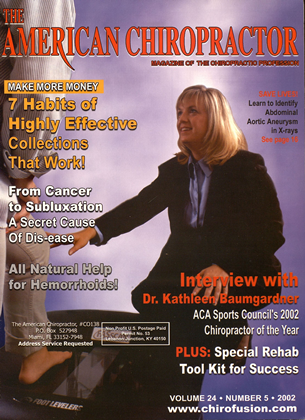When it comes to the repetitive tasks of providing consistent patient education and practice management, it only makes sense to rely upon computer technology Although we all want to focus on patient care in our practices, the reality is that we are required to handle issues related to billing, scheduling, co-pays, documentation, patient education and other aspects of patient man- agement on a daily basis. It is very difficult to ensure that all our patients receive the same level of attention in these areas. Traditionally, we rely upon our staff to handle as many of these issues as possible; but wouldn't it be simpler and easier if a computer could handle many, if not most, of these tasks? When it comes to the repetitive tasks of providing consistent patient education and practice management, it only makes sense to rely upon computer technology, when possible. The problem, of course, is that all of these systems are on separate computers that do not "talk" to each other. Wouldn't it be wonderful if we could enter patient information only once? Pull up our sEMG scans in our practice management software, creating bills automatically, including reports from our diagnostic tests, at the touch of one button? Imagine automatically scheduling your next sEMG and thermography test without input from anyone? Imagine that Mrs. Johnson walks into her chiropractor's office and uses a signature capture device to sign in. With the staff prompted by the computer, she is greeted, and directed to Room # 1. As she enters the appointed room, she notices the wall-mounted touch-screen off to the side, with information specific to her, ranging from notes regarding scheduling or billing issues to standard care information every patient might get on their 12"' visit or 20"' visit, or their birthday, for that matter. When the doctor arrives, with the touch of a finger, he brings up her last sEMG and thermography scans, perhaps even range of motions exams or X-rays. He also brings up on-screen educational material relating her sEMG findings. Utilizing impressive "high tech graphics", the doctor discusses the importance of sticking to the care plan that has been laid out. Together, they decide on a re-exam date and schedule it right on the computer. During this interaction—via the touch screen—the doctor enters a couple of notations regarding today's visit, largely as it related to the initial exam findings or her last visit. As Mrs. Johnson leaves Room #1, the front desk is notified via computer that the room is now available. Also, any billing information, notes, or scheduling changes or additions that the doctor made will be clearly reflected at the front desk. Her claims, including sEMG and ROM, are filed electronically. She is then notified via e-mail of her next appointment, and next surface EMG exam. If she is to miss her next appointment or forget to schedule a future appointment, the computer reminds the front desk, helping suggest what action to take. For the patient, what this means is 100% accountability. They are provided all appointment scan dates and information related to their case. For the doctor, this means a stress-free existence, providing consistent patient care with consistent billing and scheduling, so that nothing falls through the cracks. All patient database information, reporting, and billing is shared between computer systems, so there is no need to enter patient information twice. Sounds ideal? Sounds futuristic? Sounds like something you will see in twenty years? MyoVision and Inphasc Technologies have joined forces to provide chiropractic with the "Integrated Office" which effectively integrates your diagnostics, patient education, billing and other aspects of patient management through the inexpensive networking of your diagnostics and practice management software. EZS The author. David Marcarian, MA, is founder and president of Precision Biometrics, .supplier of the Myo Vision sEMG and Thennoglide systems. He lectures for Palmer College of Chiropractic and his course is endorsed by all U.S. chiropractic associations that mandate sEMG training. He has personally instructed more than 6,000 chiropractors on proper sEMG use. Inphase Technologies can be reached at 800-490-3780. Mr. Marcarian can be reached at 800-969-6961. or visit Ifi.s company's web site at www,myovision.com.
 View Full Issue
View Full Issue









